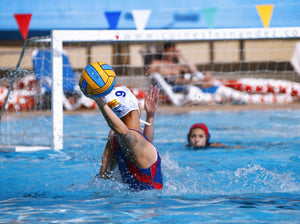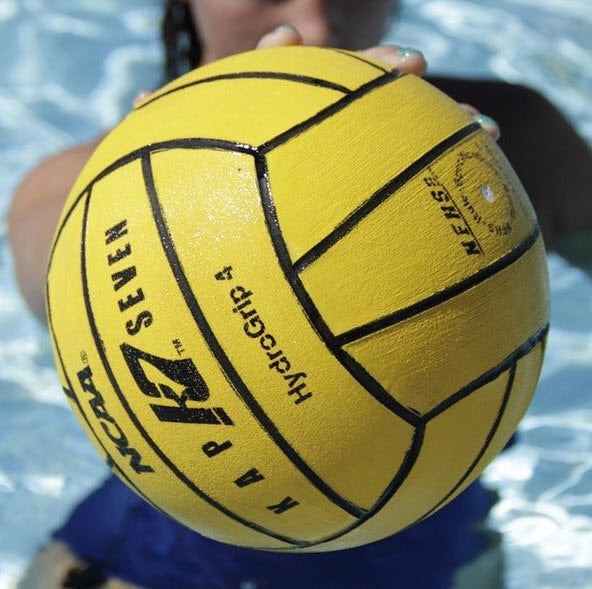Water Polo Rules & Regulations
Basic Rules

Each team has seven players in the pool: six field players and a goal keeper. Teams can substitute players while the ball is in play, but those players must enter and exit the game either in front of their team’s bench or from the corner. When the clock is stopped players can enter and exit the field of play from anywhere.
Teams score one point for a goal. The ball must cross the goal line, under the crossbar, and between the vertical posts of the goal box.
A game is played in four periods, the length of which depends on the level of play. High school and non-varsity collegiate teams play five- to seven-minute periods. College Varsity games have eight-minute periods, as do Olympic and FINA World League games. The game clock stops when a goal is scored and when a foul is called, and is restarted when the game is resumed by the non-scoring team and when the free throw is made, respectively.
In addition to the game clock, there is a shot clock, which gives each team 30 seconds to shoot at the goal. If a team does not take a shot within 30 seconds of gaining possession of the ball, a minor foul is called and the ball is given to the opposing team. At lower levels of competition the shot clock may count down from 35 seconds.
Each period begins with a sprint for the ball. Players line up along their goal line, usually with the fastest player closest to the referee with the ball. The referee blows the whistle to signal the start of the sprint and drops the ball at the center line. Players race first for the ball, and then to set up either their offense or defense, depending on who gained possession of the ball.
Players are allowed to touch the ball with only one hand at a time, except for the goalie who can grab the ball with two hands when he/she is inside the five-meter line. The goal keeper is the only player allowed to punch the ball, and then, may only do so inside the five-meter line.
Players are not allowed to stand on the bottom of the pool and participate in the game, except for the goal keeper, who can only do so when he/she is between the five-meter line and his/her goal. All players swim back and forth, playing offense and defense, except the goal keeper, who is not allowed to cross the half-distance line.
During the four regular periods, teams may call up to two timeouts. Timeouts are one-minute long and can only be called by the team with possession of the ball. Teams are given one timeout in overtime.
Fouls
Referees can call minor, major, misconduct, and brutality fouls. A referee may choose NOT to call a foul, if the call would give an advantage to the offending player’s team. (This is called the “advantage rule,” and is unique to water polo.)
Referees signal a minor foul with one whistle blast. Play stops and the player who was fouled is awarded a free throw. The referee will point to the player who gets the free throw and signal possession with the other arm. Examples of minor fouls include: pushing off the side or bottom of the pool; a false start; holding the ball underwater; touching the ball with two hands; hitting the arm or body of the player with the ball; punching the ball; pushing off a defender; being offsides (within 2m of the opposing goal and ahead of the ball); throwing the ball out of bounds; violating the shot clock.
A major foul is signaled by a double whistle. With the first whistle, the referee will point at the player who committed the foul. With the second whistle, the referee will point at the ejection area, where the player who committed the foul must serve a twenty-second ejection. Examples of major fouls include: offensive players intentionally contacting defenders; holding onto an offensive player; interfering with a free throw; pulling back or sinking a player; leaving the ejection area early or without permission from a referee. Players who are called for three major fouls cannot return to the game.
Misconduct is called for any unsportsmanlike behavior (including foul language), but is typically called when a player attempts to kick or hit another player or official with “malicious intent.” A player charged with misconduct is ejected for twenty seconds, at which time he/she is ejected for the remainder of the game, but can be replaced by substitute.
Brutality fouls are called when a player kicks or hits another player or official with “malicious intent.” The opposing team is awarded a penalty shot, and the player committing the foul is removed from the game for 4 minutes, during which time the team must play “man-down.” Players charged with brutality cannot re-enter the game.
Overtime
If the score is tied at the end of four regular periods, the teams will play at least one overtime period. Under NCAA (US College) rules if the score is still tied after two 3-minute overtime periods, the teams play 3-minute sudden-death periods until one team scores.
In international competition teams play as many as two 3-minute overtime periods. If the score is still tied at the end of those two periods, the teams compete in a penalty shootout. In the first round of a penalty shootout five players and a goal keeper from each team all take one penalty shot, alternating teams. If the score is still tied at the end of the first round, the same players shoot alternately until one team scores and the other misses.
More Resources:
The above rules are a general summary of water polo rules, which can vary in their details according to the governing body for a particular game or tournament. For detailed rules try these resources:
 FINA Water Polo Rules & Regulations
FINA Water Polo Rules & Regulations
 NCAA Water Polo Rules
NCAA Water Polo Rules
 USA Water Polo
USA Water Polo
 FINA Masters Water Polo Rules
FINA Masters Water Polo Rules



